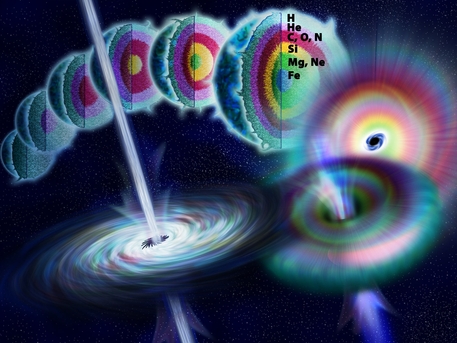Gamma-ray burst 13.1 billion light years away
New gamma-ray burst smashes cosmic distance record
 © NSF, Wikimedia
|
This drawing shows the life of a massive star as nuclear fusion converts lighter elements into heavier ones. When fusion no longer generates enough pressure to counteract gravity, the star rapidly collapses to form a black hole. Theoretically, energy may be released during the collapse along the axis of rotation to form a gamma-ray burst.
- » 1 - "True blast from the past"
- » 2 - "More about gamma-ray bursts"
"True blast from the past"
The gamma-ray burst GRB 090423 was detected the Swift satellite during the morning of Thursday 23 April 2009. The 10 second burst was located in the constellation of Leo (the Lion). It was soon being followed by a whole range of telescopes on the ground.
“We find that the light coming from the explosion has been stretched, or redshifted, considerably by the expansion of the Universe”, says Nial Tanvir, the leader of the team who made the VLT (Very Large Telescope) observations. “With a redshift of 8.2 this is the most remote gamma-ray burst ever detected, and also the most distant object ever discovered — by some way.”
Because light moves at a finite speed, looking farther into the Universe means looking back in time. The explosion occurred when the Universe was about 600 million years old, less than 5 percent of its current age. It is believed that the very first stars only formed when the Universe was between 200 and 400 million years old.
"Swift was designed to catch these very distant bursts," said Swift lead scientist Neil Gehrels at NASA's Goddard Space Flight Center. "The incredible distance to this burst exceeded our greatest expectations -- it was a true blast from the past."
“This discovery proves the importance of gamma-ray bursts in probing the most distant parts of the Universe”, says Tanvir. “We can now be confident that even more remote bursts will be found in the future, which will open a window to studying the very first stars and the ultimate end of the Dark Age of the Universe.”
The previous record holder for the most distant GRB — first detected by Swift last year and then also studied with the VLT — had a redshift of 6.7. The blast, designated GRB 080913, arose from a star exploding about 200 million years after GRB090423. The previous most distant object known in the Universe confirmed spectroscopically is a galaxy with a redshift of 6.96
Gamma-ray burst 13.1 billion light years away
New gamma-ray burst smashes cosmic distance record
 © NSF, Wikimedia
|
This drawing shows the life of a massive star as nuclear fusion converts lighter elements into heavier ones. When fusion no longer generates enough pressure to counteract gravity, the star rapidly collapses to form a black hole. Theoretically, energy may be released during the collapse along the axis of rotation to form a gamma-ray burst.
- » 1 - "True blast from the past"
- » 2 - "More about gamma-ray bursts"
"True blast from the past"
The gamma-ray burst GRB 090423 was detected the Swift satellite during the morning of Thursday 23 April 2009. The 10 second burst was located in the constellation of Leo (the Lion). It was soon being followed by a whole range of telescopes on the ground.
“We find that the light coming from the explosion has been stretched, or redshifted, considerably by the expansion of the Universe”, says Nial Tanvir, the leader of the team who made the VLT (Very Large Telescope) observations. “With a redshift of 8.2 this is the most remote gamma-ray burst ever detected, and also the most distant object ever discovered — by some way.”
Because light moves at a finite speed, looking farther into the Universe means looking back in time. The explosion occurred when the Universe was about 600 million years old, less than 5 percent of its current age. It is believed that the very first stars only formed when the Universe was between 200 and 400 million years old.
"Swift was designed to catch these very distant bursts," said Swift lead scientist Neil Gehrels at NASA's Goddard Space Flight Center. "The incredible distance to this burst exceeded our greatest expectations -- it was a true blast from the past."
“This discovery proves the importance of gamma-ray bursts in probing the most distant parts of the Universe”, says Tanvir. “We can now be confident that even more remote bursts will be found in the future, which will open a window to studying the very first stars and the ultimate end of the Dark Age of the Universe.”
The previous record holder for the most distant GRB — first detected by Swift last year and then also studied with the VLT — had a redshift of 6.7. The blast, designated GRB 080913, arose from a star exploding about 200 million years after GRB090423. The previous most distant object known in the Universe confirmed spectroscopically is a galaxy with a redshift of 6.96






